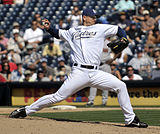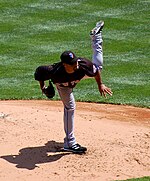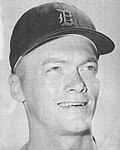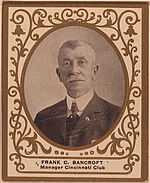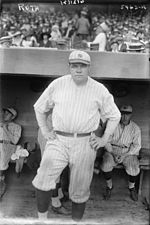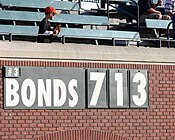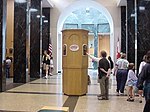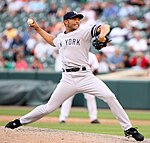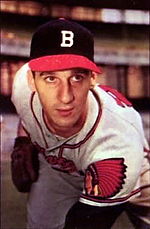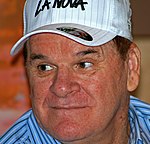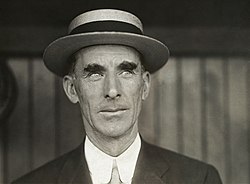Portal:Baseball/Selected list
| This Wikipedia page has been superseded by Portal:Baseball and is retained primarily for historical reference. |
| Note: List entries are now being transcluded directly on the main portal page. However, this page should be retained for historical reference. |
The Selected list box on the portal chooses one of the following at random when displaying the page. Follow the instructions below for adding a new article Featured list to the list.
Usage
[edit]Baseball related Featured Lists can be added directly to this list without nomination. All other articles should be nominated first to ensure that we only display our best work on the portal. The procedure for nomination is at the bottom of this page.
Template
[edit]{{Portal:Baseball/Selected list/Layout
|image=
|size=
|caption=
|text=
|link=
}}<noinclude>
[[Category:Baseball portal selected lists|{{SUBPAGENAME}}]]
</noinclude>
Note that the prefix Image: is not required when using this template, also - the template will auto-wikilink the article entered in the link= field. Further information on this template can be found at Portal:Baseball/Selected list/Layout.
To add a new article
[edit]- Click on the next successive empty entry or red link from this page.
- Copy the information from the list
- Save the page.
- Go to the main Portal:Baseball page.
- Click on edit page.
- Update "max=" to its new total for the {{Random portal component}} on the main page. The line which is edited is this one: {{Random portal component|max=4|header=Selected list|subpage=Selected list}} Make sure that "max=" is the same numerical value as the list entry added above (i.e. if you added list 43, then max=43)
Selected lists list
[edit]Lists 1 - 10
[edit]Portal:Baseball/Selected list/1
The Hank Aaron Award is given annually to the Major League Baseball (MLB) players selected as the top hitter in each league, as voted on by baseball fans and members of the media. It was introduced in 1999 to commemorate the 25th anniversary of Hank Aaron's surpassing of Babe Ruth's career home run mark of 714 home runs. The award was the first major award to be introduced by Major League Baseball in more than 25 years. For the 1999 season, a winner was selected using an objective points system. Hits, home runs, and runs batted in (RBI) were given certain point values and the winner was the player who had the highest tabulated points total. In 2000, the system was changed to a ballot in which each MLB team's radio and television play-by-play broadcasters and color analysts voted for three players in each league. Their first place vote receives five points, the second place vote receives three points, and the third place vote receives one point. Beginning in 2003, fans were given the opportunity to vote via MLB's official website, MLB.com. Fans' votes account for 30% of the points, while broadcasters' and analysts' votes account for the other 70%. The first winners of the award were Manny Ramirez and Sammy Sosa in 1999, while the most recent winners are Kevin Youkilis and Aramis Ramirez. Alex Rodriguez has won the award four times, the most of any player. Barry Bonds has won the award three times, the second-most of any player. The winner with the most hits is Todd Helton, who won as a Colorado Rockie in 2000. The winner with the most home runs is Barry Bonds from 2001, and Manny Ramírez in 1999 has the most RBIs.
Portal:Baseball/Selected list/2
In Major League Baseball, the Manager of the Year Award is an honor given annually since 1983 to the best managers in the American League (AL) and the National League (NL). The winner is voted on by 28 members of the Baseball Writers' Association of America (BBWAA). Each places a vote for first, second, and third place among the managers of each league. The manager with the highest score in each league wins the award. Several managers have won the award in a season when they led their team to 100 or more wins. Lou Piniella won 116 games with the Seattle Mariners in 2001, the most by a winning manager, and Joe Torre won 114 with the New York Yankees in 1998. Tony La Russa and Sparky Anderson finished with identical 104–58 records in 1983 and 1988, respectively. Three National League managers, including Dusty Baker, Whitey Herzog, and Larry Dierker, have exceeded the century mark as well. Baker's San Francisco Giants won 103 games in 1993; Dierker's 1998 Houston Astros won 102 and Herzog led the Cardinals to 101 wins in the award's third season. In 1991, Bobby Cox became the first manager to win the award in both leagues, winning with the Atlanta Braves and having previously won with the Toronto Blue Jays in 1985. La Russa, Piniella, and Jim Leyland have since won the award in both leagues. Baker, Leyland, and Piniella have won three times. In 2005, Cox became the first manager to win the award in consecutive years. Joe Maddon and Piniella are the most recent winners. After the 1994–95 Major League Baseball strike cut the season short and cancelled the post-season, the BBWAA writers named the managers of the Yankees (Buck Showalter) and Montréal Expos (Felipe Alou), who led the leagues in winning percentage, Managers of the Year. Two franchises, the New York Mets and the Milwaukee Brewers, have not had a manager win the award.
Portal:Baseball/Selected list/3
The Rolaids Relief Man Award is an annual Major League Baseball (MLB) award given since the 1976 MLB season to the top relief pitchers of the regular season, one in the American League (AL) and one in the National League (NL). Relief pitchers are the pitchers who enter the game after the starting pitcher is removed. The award is sponsored by Rolaids, whose slogan is "R-O-L-A-I-D-S spells relief." Because the first closers were nicknamed "firemen," a reference to "putting out the fire" of another team's rally, the trophy is a gold-plated firefighter's helmet. Unlike other awards, such as the Cy Young Award or the MLB Most Valuable Player (MVP) Award, the Relief Man of the Year is based on statistical performance, rather than votes. Each save is worth three points; each win is worth two points; and each loss is worth negative two points. Beginning with the 1987 MLB season, negative two points have been given for blown saves. In the 2000 MLB season, the term "tough save", which is worth an additional point, was introduced by Rolaids. A "tough save" happens when a relief pitcher enters the game already having a tying run on base, and gets the save. The player with the highest point total wins the award. The inaugural award winners were Bill Campbell (AL) and Rawly Eastwick (NL); Campbell also won in the following season. Dan Quisenberry has won the award five times, while Rollie Fingers, Bruce Sutter and Mariano Rivera have won the award four times. Lee Smith has won the award on three occasions; Campbell, Dennis Eckersley, Dave Righetti, John Franco, Éric Gagné, Randy Myers, Trevor Hoffman, and Francisco Rodriguez have won the award twice. Fingers (AL 1981) and Eckersley (AL 1992) have won the Relief Man of the Year, the Cy Young Award, and the MLB MVP Award in the same season. Sutter (NL 1979), Steve Bedrosian (NL 1987), Mark Davis (NL 1989), and Éric Gagné (NL 2003) have won the Relief Man of the Year and the Cy Young Award in the same season. Todd Worrell won both the Relief Man of the Year and the MLB Rookie of the Year Award in the 1986 MLB season. Goose Gossage, Fingers, Eckersley, and Sutter have been elected to the Baseball Hall of Fame. The most recent award winners are Rodriguez (AL) and Brad Lidge (NL).
Portal:Baseball/Selected list/4
The Boston Red Sox are a professional baseball team based in Boston, Massachusetts. The Red Sox are members of the American League (AL) East Division in Major League Baseball (MLB). There have been 43 different managers in their franchise history; four during the era of the Boston Americans (1901–1907) and the rest under the Boston Red Sox (1908–present). In baseball, the head coach of a team is called the manager, or more formally, the field manager. Since 1912, the Red Sox have played their home games at Fenway Park. Jimmy Collins was the first manager of the Americans and managed from 1901 to 1906. Joe Cronin managed the most games with 1,987 and wins with 1,071 with the Red Sox. He is followed by Pinky Higgins in both categories with 1,116 games and 560 wins. Terry Francona, the current manager of the Red Sox, has managed the most playoff games with 42 and wins with 28. Bill Carrigan and Francona have each won two World Series championships. Carrigan won his two championships in 1915 and 1916, while Francona won his two championships in 2004 and 2007. John McNamara and Jimy Williams are the only two Red Sox managers to win the AL Manager of the Year Award, in 1986 and 1999 respectively.
Portal:Baseball/Selected list/5
The New York Mets are a Major League Baseball (MLB) franchise based in Flushing, Queens, in New York City, New York. They play in the National League East division. The New York Mets have used 19 different Opening Day starting pitchers in their 48 seasons. The 19 starters have a combined Opening Day record of 25 wins, 11 losses (25–11) and 12 no decisions. Tom Seaver holds the Mets' record for most Opening Day starts with 11, and has an Opening Day record of 6–0. He also has the most starts in Shea Stadium, the Mets' home ballpark from 1964 through 2008. Dwight Gooden holds the Mets' record for most Opening Day wins with seven Opening Day wins against one Opening Day loss. Al Jackson and Roger Craig share the worst winning percentage as the Opening Day starting pitcher with a record of 0–2. From 1968 through 1983, Mets' Opening Day starting pitchers went 16 consecutive years without a loss. During this period, Tom Seaver won six starts with five no decisions, Craig Swan won two starts, and Jerry Koosman, Pat Zachry and Randy Jones won one start apiece. Furthermore, in the 31-year period from 1968 through 1998, Mets' Opening Day starting pitchers only lost two games. During that period, they won 19 games with 10 no decisions. The only losses during this period were by Mike Torrez in 1984 and by Dwight Gooden in 1990. Overall, Mets Opening Day starting pitchers have a record of 0–1 at the Polo Grounds and a 13–5 record with four no decisions at Shea Stadium. In addition, although the Mets were nominally the home team in 2000, the game was played in Tokyo Dome in Tokyo, Japan. Mike Hampton started the game in Tokyo and lost, making the Mets' Opening Day starting pitchers' combined home record 13–7, and their away record 12–4. The Mets went on to play in the World Series in 1969, 1973, 1986 and 2000, and won the 1969 and 1986 World Series championship games. Tom Seaver (1969 and 1973), Dwight Gooden (1986) and Mike Hampton (2000) were the Opening Day starting pitchers when the Mets played in the World Series, and they had a combined Opening Day record of 2–1.
Portal:Baseball/Selected list/6
The Arizona Diamondbacks are a professional baseball team based in Phoenix, Arizona. The Diamondbacks are a member of both the Major League Baseball’s (MLB) National League Western Division and the National League (NL) itself. Since the 1998 season, the Diamondbacks have played in Chase Field (formerly named "Bank One Ballpark"). The name "Diamondback", inspired by the Western diamondback snake, was chosen among thousands of entries that were received from a contest to name the team. Arizona made their Major League debut in the 1998 baseball season, where they were an expansion team. After losing their first season, the Diamondbacks were the National League West Division Champions in the 1999 baseball season and made it to the National League Division Series where they lost to the New York Mets. They rebounded in 2001, however, and defeated the New York Yankees four games to three to win the 2001 World Series. In the 2002 baseball season, Arizona made it back to the National League Division Series, but lost to the St. Louis Cardinals. In the following four seasons, the Diamondbacks didn't make it into the playoffs. Arizona would, however, win their division in 2007, but only to lose to the Colorado Rockies in the National League Championship Series. The following season, Arizona just missed the playoffs, after the National League West was won by the Los Angeles Dodgers.
Portal:Baseball/Selected list/7
The Boston Reds were a Major League Baseball franchise that played in the Players' League (PL) in 1890, and one season in the American Association (AA) in 1891. In both seasons, the Reds were their league's champion, making them the second team to win back-to-back championships in two different leagues. The first franchise to accomplish this feat was the Brooklyn Bridegrooms, who won the AA championship in 1889 and the National League (NL) championship in 1890. The Reds played their home games at the Congress Street Grounds. The Reds were an instant success on the field and in the public's opinion. The team signed several top-level players, and they played in a larger, more comfortable and modern ballpark than the Boston Beaneaters, the popular and well established cross-town rival. Player signings that first year included future Hall of Famers King Kelly, Dan Brouthers, and Charles Radbourn, along with other veterans such as Hardy Richardson, Matt Kilroy, Harry Stovey, and Tom Brown. The PL ended after one season, leaving most of its teams without a league. After the dissolution of the PL, the AA voted to allow the Reds into the new combined league. This was based on the condition that all players be returned to their former clubs via the reserve clause. Although the team's on-field captain, Kelly, became the player-manager for a new AA club, the Cincinnati Kelly's Killers, the Reds stayed intact by keeping several of their top players. Of the club's key players from the previous year's team, Brouthers, Richardson, and Brown were retained. To fill the void of the departing players, the team brought in future Hall of Famers Hugh Duffy and Clark Griffith, along with solid veterans Paul Radford, Charlie Buffinton, and George Haddock. When the 1891 season ended, the AA folded as well, leaving the NL as the sole major league, and the Reds were bought out by the surviving NL clubs.
Portal:Baseball/Selected list/8
All-Star Final Vote is an annual Internet and text message ballot by Major League Baseball fans to elect the final player for each team that participates in the Major League Baseball All-Star Game after all other selections have been made and announced on national television. The first 32 players are selected by a combination of procedures. The 2009 edition of the process, which ran from 2:00 p.m of July 5 until 4:00 pm on July 9, 2009, was named the "2009 All-Star Game Sprint Final Vote." In the most recent ballot for the 2009 Major League Baseball All-Star Game announced on July 5, 2009, National League players Cristian Guzmán, Matt Kemp, Mark Reynolds, Pablo Sandoval, and Shane Victorino and American League players Chone Figgins, Brandon Inge, Ian Kinsler, Adam Lind, and Carlos Peña were on the ballot. Ultimately, Inge and Victorino were elected to represent their respective leagues. A record 68.6 million votes were cast. That figure far exceeded the previous year's record of 47.8 million votes that elected Evan Longoria and Corey Hart to the 2008 Major League Baseball All-Star Game. The 68.6 million votes representing 34.3 million ballots exceeded the 17.8 million ballots cast for the starting lineup.
Portal:Baseball/Selected list/9
The Philadelphia Phillies are a Major League Baseball franchise based in Philadelphia, Pennsylvania. They play in the National League East division. Also known in their early years as the "Philadelphia Quakers", pitchers for the Phillies have thrown eleven separate no-hitters in franchise history. Of the eleven no-hitters pitched by Phillies players, three have been won by a score of 6–0, and three have been 1–0. The largest margin of victory in a Phillies no-hitter was ten runs, in a 10–0 win by Chick Fraser. Three Phillies players have won their no-hitters by a one-run margin; Charlie Ferguson's no-hitter, the first in franchise history, was a 1–0 victory, one thrown by Kevin Millwood in 2003, and the one thrown by Roy Halladay against the Florida Marlins in 2010. Two pitchers to throw no-hitters for the Phillies have been left-handed: Johnny Lush (in 1906) and Terry Mulholland (in 1990). The other eight pitchers were right-handed. One pitcher has thrown more than one no-hitter in a Phillies uniform, that being Halladay. Some, including Hall of Famer Jim Bunning, have pitched more than one in their careers, but not more than one for the Phillies. The longest interval between Phillies no-hitters was between the games pitched by Lush and Bunning, encompassing 58 years, 1 month, and 20 days. Conversely, the shortest interval between no-hitters was between both of Halladays (131 Days). A different umpire presided over each of the Phillies' eleven no-hitters, including Wes Curry, who created Major League Baseball's catcher interference rule. Two perfect games, a special subcategory of no-hitter, has been pitched in Phillies history. The first was achieved by Bunning in 1964 and was the first perfect game in the National League since 1880. The second was by Halladay against the Florida Marlins. Halladay also pitched the second postseason no hitter in MLB history against the Reds in the National League Divisional Series NLDS. As defined by Major League Baseball, "[in] a perfect game, no batter reaches any base during the course of the game."
Portal:Baseball/Selected list/10
The First-Year Player Draft, also known as the Rule 4 Draft, is Major League Baseball's (MLB) primary mechanism for assigning amateur baseball players from high schools, colleges, and other amateur baseball clubs to its teams.
Unlike most professional sports, MLB does not permit the trading of draft picks, so the draft order is solely determined by the previous season's standings; the team that possesses the worst record receives the first pick. If two teams have identical records, the team with the worse record in the previous season will receive the higher pick. In addition, teams that lost free agents in the previous off-season may be awarded "compensatory" picks.
The first draft took place in 1965; it was introduced to prevent richer teams from negotiating wealthier contracts with top-level prospects and therefore, monopolizing the player market. Originally, three drafts were held each year. The first draft took place in June and involved high-school graduates and college seniors who had just finished their seasons. The second draft took place in January for high school and college players who had graduated in December. The third draft took place in August and was for players who participated in American amateur summer leagues. The August draft was eliminated after two years, and the January draft lasted until 1986.
Overall, 18 of the 45 first overall draft picks have participated in the All-Star Game, and two, Bob Horner and Darryl Strawberry, have won the Rookie of the Year Award. Twenty of the forty-five picks have been drafted from high schools, one has been drafted out of the Independent American Association, and the others were drafted from universities. To date, Arizona State University has been the only school from which multiple number-one overall draft picks have been chosen. Out of all the first overall picks, only Ken Griffey Jr. has been elected to the Hall of Fame.
Lists 11 - 20
[edit]Portal:Baseball/Selected list/11
Puerto Rico currently has the second-most active players in Major League Baseball (MLB) among Latin-American countries, behind only the Dominican Republic. More than two-hundred players from the archipelago have played in the league since 1942. This includes players that were born in either one of the archipelago's islands and immigrants of Puerto Rican heritage that have represented Puerto Rico in international competition. Only those players that have worked in the league are listed, not those active in the minor leagues. The first player from the Puerto Rico to play in MLB was Hiram Bithorn. After the baseball color line was abandoned following Jackie Robinson's debut in the league, more players from the island signed contracts. This led to an improvement in their performance, and some of them were selected to participate in the Major League Baseball All-Star Game. Including their names in the Major League Baseball Draft is a requisite for first-year players born in Puerto Rico, because the league recognizes the island as a jurisdiction within the United States. Following the implementation of this measure, Puerto Rico's government requested exclusion from the draft and help to develop players, in order to reduce the impact of the change in the format of talent development.
Portal:Baseball/Selected list/12
The Worcester Worcesters, sometimes referred to as the Brown Stockings or the Ruby Legs, were a Major League Baseball team based in Worcester, Massachusetts. Though the team's alternate names appear in many modern sources, no contemporary records from the time exist that support the use of names other than "Worcester". They existed in the National League (NL) from 1880 to 1882, and played their home games at the Worcester Agricultural Fairgrounds. The team was organized in 1879 as the Worcester Baseball Association, and joined the minor league National Association. The team was profitable, successful against rival teams, and did well against NL teams in exhibition games. After the season, team management turned their attention on the NL, and pursued the slot vacated by the departing Syracuse Stars. The team was voted into the NL by a majority of the owners, and in 1880, the team began their first season. The manager of the team, Frank Bancroft, and many of the players stayed with the team when it joined the NL, including pitchers Lee Richmond and Tricky Nichols, and position players Arthur Irwin, Doc Bushong, Charlie Bennett, and Chub Sullivan. On June 12, Richmond threw the first perfect game in major league history, against the Cleveland Blues. Harry Stovey, in his first major league season, led the league in triples and home runs. However, the Ruby Legs were, in turn, no-hit on August 20 by Pud Galvin of the Buffalo Bisons, becoming the first team to be no-hit at home. They played 85 games in their first season, and had a win–loss record of 40 wins, 43 losses, with 2 ties, finishing fifth in the league. By 1882, the team had declined, and the pitchers began to complain of exhaustion and accused management of overuse. A second consecutive last-place finish, along with declining talent, their fans stopped attending home games, with attendance numbers averaging 50 paid spectators. John Clarkson, who went on to win 328 games in a 12-season career, and was the only Hall of Famer to have played for the franchise, began his career for the 1881 Ruby Legs. When the season ended, the NL decided to drop the team from the league, replacing them with the Philadelphia Quakers, who later became the Phillies.
Portal:Baseball/Selected list/13
There have been 19 different captains of the Boston Red Sox, an American professional baseball franchise also known previously as the Boston Americans. This is a comprehensive list of these captains. The Boston Red Sox are the 2007 World Series Champions. They are members and current champions of both the Major League Baseball’s (MLB) American League Eastern Division and of the American League (AL). The "Red Sox" team name originates from the iconic uniform feature. They are sometimes nicknamed the "BoSox", a combination of "Boston" and "Sox" (as opposed to the "ChiSox"), the "Crimson Hose", and "the Olde Towne Team". Most fans simply refer to them as "the Sox". In Major League Baseball, a captain is an honorary title given to the member of the team primarily responsible for strategy and teamwork while the game is in progress on the field. This role has been particularly important during eras and situations in which managers and coaches have been precluded by the rules from interacting with players on the field while the game is in progress. As is the case with the National Hockey League, some MLB captains (such as the Red Sox' Jason Varitek) wear a distinctive "C" on the left side of their jersey.
Portal:Baseball/Selected list/14
The Silver Slugger Award is awarded annually to the best offensive player at each position in both the American League (AL) and the National League (NL), as determined by the coaches and managers of Major League Baseball (MLB). These voters consider several offensive categories in selecting the winners, including batting average, slugging percentage, and on-base percentage, in addition to "coaches' and managers' general impressions of a player's overall offensive value". Managers and coaches are not permitted to vote for players on their own team. The Silver Slugger was first awarded in 1980 and is given by Hillerich & Bradsby, the manufacturer of Louisville Slugger bats. The award is a bat-shaped trophy, 3 feet (91 cm) tall, engraved with the names of each of the winners from the league and plated with sterling silver. Designated hitters (DH) only receive a Silver Slugger Award in the American League because the batting order in the National League includes the pitcher; therefore, pitchers receive the National League award instead.
Three players are tied for the most Silver Slugger wins among designated hitters. Paul Molitor won the award four times with three different teams: the Milwaukee Brewers in 1987 and 1988; the Toronto Blue Jays in 1993, when the team won the World Series; and the Minnesota Twins in 1996. Edgar Martínez won the award four times with the Seattle Mariners (1995, 1997, 2001, 2003), and David Ortiz won four consecutively from 2004 to 2007. Don Baylor won the Silver Slugger three times in four years (1983, 1985–1986) as a designated hitter with the New York Yankees and the Boston Red Sox, and Frank Thomas won it twice with the Chicago White Sox (1991, 2000). Harold Baines won the award while playing for two separate teams in the same season; he was traded by the White Sox to the Texas Rangers in the middle of the 1989 season. Aubrey Huff is the most recent winner. Martínez set the records for the highest batting average and on-base percentage in a designated hitter's winning season with his .356 and .479 marks, respectively, in 1995. Manny Ramírez' slugging percentage of .647 is best among all winners at the position. Ortiz hit 54 home runs during the 2006 season, when he won his third consecutive award, and his 2005 total of 148 runs batted in is tied with Rafael Palmeiro's 1999 mark for best among designated hitters.
Portal:Baseball/Selected list/15
The Rawlings Gold Glove Award, usually referred to as the Gold Glove, is the award given annually to the Major League Baseball players judged to have exhibited superior individual fielding performances at each fielding position in both the National League (NL) and the American League (AL), as voted by the managers and coaches in each league. Managers are not permitted to vote for their own players. Eighteen Gold Gloves are awarded each year (with the exception of 1957, 1985 and 2007), one at each of the nine positions in each league. In 1957, the baseball glove manufacturer Rawlings created the Gold Glove Award to commemorate the best fielding performance at each position. The award was created from a glove made from gold lamé-tanned leather and affixed to a walnut base. Initially, only one Gold Glove per position was awarded to the top fielder at each position in the entire league; however, separate awards were given for the National and American Leagues beginning in 1958.
Greg Maddux has won the most Gold Glove Awards among all players, including pitchers, in Major League Baseball history. He won 18 awards, all in the National League; his streak of wins was consecutive from 1990 through 2002 until interrupted by Mike Hampton in 2003. Maddux won five more awards from 2004 to 2008, after which he retired. Jim Kaat is second and held the record for most wins (16) until he was displaced by Maddux in 2007. He won 14 awards in the American League and 2 in the National League; his 16 consecutive awards is a record among winners. Bob Gibson won nine Gold Gloves with the St. Louis Cardinals, and the inaugural winner Bobby Shantz won four awards in each league, for a total of eight. Mark Langston and Mike Mussina are tied for the fifth-highest total, with seven wins each. Five-time awardees include Ron Guidry, Phil Niekro, and Kenny Rogers; Jim Palmer has won four times. Gold Glove winners at pitcher who have been inducted into the Baseball Hall of Fame include Gibson, Palmer, and Niekro.
Portal:Baseball/Selected list/16
The New York Yankees are a professional baseball team based in the Bronx, New York. They compete in the East Division of Major League Baseball's (MLB) American League (AL). After beginning play in Baltimore, Maryland as the Baltimore Orioles in 1901, the club moved to New York two years later and became the Highlanders; in 1913, the team changed its nickname to the Yankees. From 1901 to 2008, the franchise has won more than 9,000 games and 26 World Series championships.
The list below documents players and teams that hold particular club records. Outfielder Babe Ruth holds the most franchise records, with 15, including career and single-season home runs, batting average, and on-base percentage. First baseman Lou Gehrig has the second-most records among hitters, with five; his marks include career and single-season runs batted in and career hits. Among pitchers, Whitey Ford has the most Yankees records with six, all of which are career totals. These include games won, strikeouts, and innings pitched.
Several Yankees hold AL and MLB records. Ruth has MLB single-season records for extra-base hits and total bases, and holds four other AL single-season records. Outfielder Joe DiMaggio recorded hits in 56 consecutive games in the 1941 season, a total that remains an MLB record. Chesbro holds three AL records—games won, games started, and complete games—that were set in 1904. Pitcher Spud Chandler, who spent his entire career with the Yankees, holds the all-time AL record for the highest winning percentage.
Portal:Baseball/Selected list/17
The Cincinnati Reds are an American professional baseball franchise based in Cincinnati, Ohio. They are members of the National League Central Division in Major League Baseball. In chronological order, the Reds have played their home games in the Bank Street Grounds, League Park, the Palace of the Fans, Redland Field (later known as Crosley Field), and Riverfront Stadium (later known as Cinergy Field). Since 2003, the Reds have played their home games at Great American Ball Park. There have been fifty-nine different managers in the team's franchise history: four while it was known as the Cincinnati Red Stockings (1882–1889), four while it was known as the Cincinnati Redlegs (1953–1958) and the other fifty-one under the Cincinnati Reds (1882–1952, 1959–present). In baseball, the head coach of a team is called the manager, or more formally, the field manager. Pop Snyder was the first manager of the Reds and managed from 1882 to 1884. Sparky Anderson is the franchise's all-time leader in regular-season games managed (1,450) and regular-season game wins (863). He is followed by Bill McKechnie in both categories with 1,386 and 744, respectively. Anderson is the only Reds manager to have won the World Series twice, in 1975 and 1976. Pat Moran, Lou Piniella, and McKechnie have one World Series victory each; Moran was the manager during the Black Sox Scandal, which refers to the events that took place in the 1919 World Series. McKechnie led the team to the championship in 1940, while Piniella led the team to it in 1990. Jack McKeon is the only manager to have won the Manager of the Year Award with the Reds, which he won in 1999. The current manager of the Reds is Dusty Baker, and the current owner is Robert Castellini. The manager with the highest winning percentage over a full season or more was Pop Snyder, with a winning percentage of .648. Conversely, the worst winning percentage over a full season or more in franchise history is .382 by Donie Bush, who posted a 58–94 record during the 1933 season.
Portal:Baseball/Selected list/18
Milestone home runs by Barry Bonds have been those important home runs hit by Barry Bonds, who ranks among the greatest baseball players of all time and has for much of his career been considered a five-tool player. Bonds' ascension towards the top of experts' lists of greatest players was propelled by highly productive years in which he set many records. By 1998, he was considered among the 50 greatest players of all time by The Sporting News, and after winning the National League's Most Valuable Player Award four consecutive times from 2001 to 2004, he jumped into the top 10 in the 2005 list. He now holds numerous Major League Baseball records for home runs, bases on balls, intentional bases on balls, slugging percentage and on-base percentage, as well as a record seven MVP awards.
In baseball, the home run is one of the most popular aspects of the game. Thus, the career record for home runs is among the most important and respected records in baseball. The road to this record has been closely followed and each additional home run Bonds hits extends the current record further. On August 7, 2007, Barry Bonds became the major leagues' career home run champion by hitting his 756th career home run, which surpassed Hank Aaron's total.
Quite often milestone home runs such as round hundred and career records are considered breaking news, and sports news services give coverage to countdowns on impending milestone home runs. Several of Bonds' milestone home runs were given dedicated coverage on ESPN BottomLine, with Chasing Ruth and Chasing Aaron coverage being quite extensive for the few seasons preceding the breaking of the record.
Sports collectible dealers and buyers pay exorbitant sums for paraphernalia associated with such milestones. The Baseball Hall of Fame covets such paraphernalia for display. In fact, players are even sensitive to the way in which their paraphernalia is displayed. A baseball that was hit for a milestone causes such a mêlée and such hysteria that special balls have to be used to stop counterfeiting, and police escorts are necessary for those who catch such balls.
Portal:Baseball/Selected list/19
The Pittsburgh Pirates are a Major League Baseball (MLB) franchise based in Pittsburgh, Pennsylvania. They play in the National League Central division. The team began play in 1882 as the Alleghenies (alternately spelled "Alleghenys") in the American Association. The franchise moved to the National League after owner William Nimick became upset over a contract dispute, thus beginning the modern day franchise. The team currently plays home games at PNC Park which they moved into in 2001. Prior to PNC Park, the Pirates played games at Three Rivers Stadium and Forbes Field, among other stadiums. Through the 2008 season the Pirates have had 16 consecutive seasons with a losing record—tying a United States professional sports record.
There have been 38 managers for the Pittsburgh Pirates franchise. The Pirates' first manager was Horace Phillips, who had coached the team before their move to the National League. In 1900, Fred Clarke began his tenure with the franchise. Clarke's 1422 victories and 969 losses lead all managers of the Pirates in their respective categories, Clarke also had the longest tenure as manager in his 16 years in the position. Clarke managed the franchise to its first World Series victory, a feat that would also be accomplished by Bill McKechnie, Danny Murtaugh, and Chuck Tanner. Thirteen Pirates managers have been player-managers—those who take on simultaneous roles as a player and manager. McKechnie, Connie Mack, and Ned Hanlon were inducted into the National Baseball Hall of Fame and Museum as managers. Five Pirates managers were inducted into the Hall of Fame for their performance as players. Billy Meyer's number 1, Pie Traynor's number 20, Honus Wagner's number 33, and Murtaugh's number 40 have been retired by the franchise. Hired before the 2011 season, the Pirates' current manager is [Clint Hurdle].
From the franchise's beginning, the owner and manager fulfilled the duties of the general manager. However, in 1946, Roy Hamey left his position as president of the second American Association to become the Pirates' first general manager. The franchises' second general manager, Branch Rickey, was elected to the Hall of Fame in 1967. Hired in September 2007, Neal Huntington is the Pirates's current general manager. Barney Dreyfuss purchased the franchise in 1900, bringing players including Honus Wagner and Fred Clarke with him from the Louisville Colonels, which he had previously owned. In his 32 years as owner, Dreyfuss built Forbes Field and helped to organize the World Series. Dreyfuss was elected to the Hall of Fame in 2008. Robert Nutting served as Chairman of the Board from 2003 to 2007, at which point he became majority owner of the franchise.
Portal:Baseball/Selected list/20
The National Baseball Hall of Fame and Museum is an American museum and hall of fame that is the central point for the study of the history of baseball in the United States and beyond, the display of baseball-related artifacts and exhibits, and the honoring of persons who have excelled in playing, managing, and serving the sport. Elections commenced in 1936 for the selection of worthy individuals to be honored by induction to the Baseball Hall of Fame, though the first induction ceremonies were not held until the Hall opened in 1939. As of July 2009[update], a total of 292 individuals have been selected, including 231 players, 19 managers, 8 umpires, and 31 pioneers and executives. Each is listed along with his primary position; that is, the position or role in which the player made his greatest contribution to baseball, according to the Hall of Fame.
According to the current rules, players must have at least 10 years of major league experience and be retired for at least 5 years to be inducted. Players meeting these qualifications must pass through a screening committee, and are then voted on by the Baseball Writers' Association of America (BBWAA). Each writer may vote for up to 10 players; to be admitted into the Hall of Fame, a player must be approved by 75% of those casting ballots. Players receiving less than 5% approval are removed from future BBWAA ballots. The current rules, most recently revised in July 2007, allow that all players whose careers began in 1943 or later who have not been approved by the BBWAA election process within 20 years of their retirement may be considered by the Veterans Committee in every odd-numbered year, and that umpires, managers, pioneers, and executives may be considered by that committee in even-numbered years. Under the 2007 revised rules, players whose careers began in 1942 or earlier are considered every five years by a special panel selected by the Hall of Fame. Over the years, exceptions have been made to the guidelines in place at the time: Roberto Clemente was elected shortly after his death in 1972; Lou Gehrig was elected in 1939 following his diagnosis with amyotrophic lateral sclerosis; and Addie Joss was elected in 1978 although he completed only nine seasons before his death.
Between 1971 and 1977, nine players from the Negro Leagues were inducted by a special Negro Leagues Committee, which was given the task of identifying worthy players who played in the Negro Leagues prior to the breaking of baseball's color line. Since 1977, players from the Negro Leagues have been considered by the Veterans Committee, and nine more individuals have been approved by that body. In 2005, the Hall announced the formation of a Committee on African-American Baseball, which held a 2006 election for eligible figures from the Negro Leagues and earlier 19th-century teams; Seventeen additional Negro League figures were chosen in that election, including executive Effa Manley, the first woman inducted.
Lists 21 - 29
[edit]Portal:Baseball/Selected list/21
The Babe Ruth Award is given annually to the Major League Baseball (MLB) player with the best performance in the postseason. The award, created by the New York chapter of the Baseball Writers' Association of America (BBWAA) in honor of Babe Ruth, was first awarded in 1949 to the MVP of the World Series, one year after Ruth's death. The award continued to be awarded exclusively for performances in the World Series until 2007, when the New York chapter of the BBWAA changed the award to cover the entire postseason. Though it precedes the World Series Most Valuable Player Award, which was not created until 1955, the Babe Ruth Award is considered less prestigious, as it is not sanctioned by MLB and is awarded several weeks after the World Series.
MLB expanded its postseason to include the League Championship Series (LCS) in 1969 and the League Division Series (LDS) in 1995. The LDS follows a best-of-five playoff format, while the LCS and World Series follow a best-of-seven playoff format. The most recent World Series champions are the St. Louis Cardinals, who won in 2011. David Freese, the most recent recipient of the Babe Ruth Award, also won the NLCS and World Series MVP awards in 2011. Ruth was a noted slugger who batted .326 with 15 home runs and three wins in three games started as a pitcher during World Series play. However, the Babe Ruth Award does not only go to sluggers or pitchers. Dick Green won the award for the 1974 World Series, in which he batted 0-for-13, but helped the Oakland Athletics win the series with his defense.
Joe Page of the New York Yankees was the first winner of the Babe Ruth Award. In all, members of the Yankees have won the award sixteen times. Luis Tiant is the only winner of the Babe Ruth Award to play for the World Series-losing team. Two players, Sandy Koufax and Jack Morris, have won the award twice.
Portal:Baseball/Selected list/22
Major League Baseball (MLB) honors its best relief pitcher monthly with the Major League Baseball Delivery Man of the Month Award and annually with the Major League Baseball Delivery Man of the Year Award. The awards were initially part of a sponsorship agreement between MLB and package delivery company DHL Express from 2005 to 2010. They are usually presented to a closer, though all relief pitchers are eligible.
From its inception in 2005 through 2008, the annual award was voted online by fans from a group of 10 finalists chosen by an MLB panel. The panel took sole responsibility to select the annual winner starting in 2009. The winner of the monthly award is decided on by a four-man panel, which originally consisted of Dennis Eckersley, Jerome Holtzman, Rick Sutcliffe and Bob Watson.
New York Yankees closer Mariano Rivera has won the award more than any other American League pitcher; he received the annual award in 2005, 2006, and 2009, and was named the monthly winner in April 2008 and July 2009. Trevor Hoffman has won four times in the National League; he won the monthly award in May 2005, September 2006, May 2007, and May 2009. Joe Nathan (July 2006, July 2008, and June 2009) and Rafael Soriano (May 2010, July 2010, and August 2010) have won the monthly award three times. Other pitchers who have won multiple times include Jonathan Papelbon (April 2006 and the 2007 annual award), Brad Lidge (July 2005 and the 2008 annual award), Heath Bell (April 2009 and the 2010 annual award), and Francisco Rodríguez (August 2006 and June 2008). J. J. Putz of the Arizona Diamondbacks is the most recent monthly winner for his performance in September 2011.
Portal:Baseball/Selected list/23
The Edgar Martínez Outstanding Designated Hitter Award, commonly referred to as the Edgar Martínez Award and originally known as the Outstanding Designated Hitter Award, has been presented annually to the most outstanding designated hitter (DH) in the American League (AL) in Major League Baseball (MLB) since 1973. The award is voted on by club beat reporters, broadcasters and AL public relations departments. All players with a minimum of 100 at bats at DH are eligible. It was given annually by members of the Associated Press who are beat writers, broadcasters, and public relations directors. The Associated Press discontinued the award in 2000, but it was picked up by the Baseball Writers' Association of America, which has administered it since.
In September 2004, at Safeco Field ceremonies in honor of Edgar Martínez, Commissioner Bud Selig announced that the award would be renamed for the five-time recipient (1995, 1997–98, 2000–01). In an 18-year career with the Seattle Mariners, primarily as a designated hitter, Martínez batted .312, with 309 career home runs and 1,261 runs batted in.
David Ortiz has won the award six times, more than any other player (2003–2007, 2011). Other repeat winners of the award include Martínez himself (five times), three-time winner Hal McRae (1976, 1980, and 1982) and two-time winners Willie Horton (1975 and 1979), Greg Luzinski (1981 and 1983), Don Baylor (1985 and 1986), Harold Baines (1987 and 1988), Dave Parker (1989 and 1990), and Paul Molitor (1993 and 1996).
Portal:Baseball/Selected list/24
The Warren Spahn Award is presented each season by the Oklahoma Sports Museum to the best left-handed pitcher in Major League Baseball (MLB). The award is named after Warren Spahn, who holds the MLB record in wins for a left-handed pitcher with 363. The Warren Spahn Award was created in 1999 by Richard Hendricks, the founder of the Oklahoma Sports Museum, to honor Spahn, who resided in Oklahoma. The award was presented at the Masonic Temple in Guthrie, Oklahoma until 2009, when the Bricktown Rotary Club became a sponsor of the award. Since 2009, the award is presented at the annual Warren Spahn Award Gala, hosted by the Bricktown Rotary Club of Oklahoma City at the Jim Thorpe Museum every January.
The award has been won by seven different pitchers over thirteen years. The winner is chosen based on rankings, which are based on wins, strikeouts and earned run average. The most recent recipient is Clayton Kershaw of the Los Angeles Dodgers. Randy Johnson received the first four awards from 1999 through 2002. He attended the awards ceremony due to his respect for Spahn, who called him personally to ask him to attend. CC Sabathia (2007–2009) and Johan Santana (2004, 2006) are also multiple Warren Spahn Award winners. Johnson (1999–2002), Santana (2004, 2006), Sabathia (2007) and Kershaw (2011) also won the Cy Young Award, given annually to the best pitcher in each league, in years they won the Warren Spahn Award. There has been one tie-break in the Warren Spahn Award's history, which occurred when Sabathia defeated the Houston Astros' Wandy Rodriguez to earn his third consecutive award in 2009. The tie-break was decided based on winning percentage.
Portal:Baseball/Selected list/25
The New York Yankees are a Major League Baseball (MLB) franchise based in The Bronx, New York. They play in the American League East division. Since the institution of Major League Baseball's Rule 4 Draft, the Yankees have selected 46 players in the first round. Officially known as the "First-Year Player Draft", the Rule 4 Draft is Major League Baseball's primary mechanism for assigning amateur baseball players from high schools, colleges, and other amateur baseball clubs to its teams. The draft order is determined based on the previous season's standings, with the team possessing the worst record receiving the first pick. In addition, teams which lost free agents in the previous off-season may be awarded compensatory or supplementary picks.
Of the 47 players the Yankees have selected in the first round, 22 were pitchers. Of these, 17 were right-handed and 5 were left-handed. The Yankees have drafted ten outfielders, six shortstops, three catchers, three first basemen, and three third basemen. The team has never drafted a player at second base. The Yankees drafted 29 players out of high school, and drafted 18 players out of college. Eleven of the players came from high schools or universities in the state of California, and Florida follows with five players.
Four first-round picks have won championships with the franchise: Thurman Munson (1977 and 1978), Derek Jeter (1996, 1998, 1999, 2000 and 2009), Phil Hughes (2009), and Joba Chamberlain (2009). Munson and Jeter have both also served as team captains for the Yankees. None of the Yankees' first-round picks have been elected to the Baseball Hall of Fame. Two of the Yankees' picks have won the MLB Rookie of the Year award; Munson won the award in 1970, and Jeter won the award in 1996.
The Yankees have made 11 selections in the supplemental round of the draft and 19 compensatory picks since the institution of the First-Year Player Draft in 1965. These additional picks are provided when a team loses a particularly valuable free agent in the previous off-season, or, more recently, if a team fails to sign a draft pick from the previous year. The Yankees have been awarded compensatory draft choices for failing to sign first round picks Tyrell Godwin (1997) and Gerrit Cole (2008). Though the Yankees also failed to sign Mark Prior (1998), they were not awarded a compensatory pick, as Prior was chosen with the pick received for Godwin, and compensatory rules only allow for one compensation pick for failing to sign a player. The Yankees have also surrendered 10 first round picks due to free agent signings.
Portal:Baseball/Selected list/26
On November 17, 1992, during the 1992–93 offseason, Major League Baseball (MLB) held an expansion draft in New York City to allow the Florida Marlins and Colorado Rockies to build their rosters prior to debuting in the National League (NL) East and the NL West divisions, respectively, in the 1993 MLB season.
The 1990 collective bargaining agreement between MLB owners and the MLB Players Association allowed the NL to expand by two members to match the American League (AL). In June 1991, MLB accepted bids of groups from Miami, Florida and Denver, Colorado, with debuts set for 1993.
The Marlins and Rockies used the expansion draft to build their teams using different strategies. As the Rockies had a smaller operating budget than the Marlins, the Rockies targeted prospects with low salaries, while the Marlins selected older players intended to provide more immediate impact. All three rounds of the draft were televised by ESPN.
Portal:Baseball/Selected list/27
Also known in their early years as the "Baltimore Orioles" (1901–02) and the "New York Highlanders" (1903–12), the New York Yankees have had ten pitchers throw eleven no-hitters in franchise history. A no-hitter is officially recognized by Major League Baseball (MLB) only "when a pitcher (or pitchers) retires each batter on the opposing team during the entire course of a game, which consists of at least nine innings". No-hitters of less than nine complete innings were previously recognized by the league as official; however, several rule alterations in 1991 changed the rule to its current form. A no-hitter is rare enough that two of the thirty teams in Major League Baseball have never had a pitcher accomplish the feat. Three perfect games, a special subcategory of no-hitter, have been pitched in Yankees history. As defined by Major League Baseball, "in a perfect game, no batter reaches any base during the course of the game." This feat was achieved by Don Larsen in 1956, David Wells in 1998, and David Cone in 1999. Wells later claimed he was a "little hung-over" while throwing his perfect game.
George Mogridge threw the first no-hitter in Yankees history, beating their rival Boston Red Sox 2–1, their only no-hitter in which the opposition scored. Their most recent no-hitter was David Cone's perfect game in 1999, the seventh Yankees no-hitter thrown by a right-handed pitcher and their third perfect game. The Yankees' first perfect game was also thrown by a right-handed pitcher, Don Larsen, and came in Game 5 of the 1956 World Series. Larsen's perfect game was the only no-hitter in MLB postseason play until Roy Halladay of the Philadelphia Phillies pitched a no-hitter in Game 1 of the 2010 National League Division Series. Coincidentally, Cone's perfect game came on "Yogi Berra Day" at Yankee Stadium. Berra had caught Larsen's perfect game and both he and Larsen were in the stands for the game. Of the eleven no-hitters pitched by Yankees players, three each have been won by the scores 4–0 and 2–0, more common than any other result. The largest margin of victory in a Yankees no-hitter was 13 runs, in a 13–0 win by Monte Pearson.
The longest interval between Yankees no-hitters was between the game pitched by Larsen on October 8, 1956 and Dave Righetti's no hitter on July 4, 1983, encompassing 26 years, 8 months, and 26 days. The shortest gap between such games fell between Allie Reynolds' two no-hitters in 1951, a gap of just 2 months and 16 days from July 12 till September 28. Reynolds is the only Yankees pitcher to throw multiple no-hitters in his career, and one of only four pitchers in Major League history to throw multiple no-hitters in a season along with Nolan Ryan in 1973, Virgil Trucks in 1952, and Johnny Vander Meer in 1938. The Red Sox and the Cleveland Indians have been no-hit by the Yankees more than any other franchise, each doing so three times. Notably, Reynolds' two no-hit victims in 1951 were the Red Sox and the Indians.
Portal:Baseball/Selected list/28
In Major League Baseball (MLB), the 3,000 hit club is a term applied to the group of batters who have collected 3,000 or more regular-season hits in their careers. Cap Anson was the first to join the club on July 18, 1897, although his precise career hit total is unclear. Two players—Nap Lajoie and Honus Wagner—reached 3,000 hits during the 1914 season. Ty Cobb became the club's fourth member in 1921 and became the first player in MLB history to reach 4,000 hits in 1927, ultimately finishing his career with more than 4,100. Cobb, also MLB's all-time career batting average leader, remained the MLB hit leader until September 11, 1985 when Pete Rose collected his 4,192nd hit. Rose, the current record holder, finished his career with 4,256 hits. Roberto Clemente's career ended with precisely 3,000 hits, reaching the mark in the last at bat of his career. Derek Jeter is the most recent player to reach the milestone, achieving the feat on July 9, 2011.
In total, 28 players have reached the 3,000 hit club in MLB history. Of these, 14 were right-handed batters, 12 were left-handed, and 2 were switch hitters, meaning they could bat from either side of the plate. Ten of these players (and the only active member of the 3,000 hit club) have played for only one major league team. The Cleveland Indians are the only franchise to see three players reach the milestone while on their roster: Lajoie (while the franchise was known as the "Naps"), Tris Speaker, and Eddie Murray. Four players—Hank Aaron, Willie Mays, Murray, and Rafael Palmeiro—are also members of the 500 home run club. Cobb holds the highest career batting average, .366, of the club while Cal Ripken Jr. holds the lowest at .276. Jeter and Wade Boggs are the only players to hit a home run for their 3,000th hit and Paul Molitor is the only player to hit a triple for his 3,000th; all others hit a double or single. Craig Biggio was thrown out at second base attempting to stretch his 3,000th hit, a single, into a double. Biggio and Jeter are the only players to join the club in a game where they had five hits; Jeter reached base safely in all of his at bats. Baseball writer Josh Pahigian wrote that the club has been "long considered the greatest measure of superior bat handling." Reaching 3,000 hits is often described as a guarantee of eventual entry into the Baseball Hall of Fame. All eligible club members, with the exception of Palmeiro, have been elected to the Hall, and since 1962 all have been elected on the first ballot. Eligibility requires that a player has "been retired five seasons" or deceased for at least six months, disqualifying two living players (Biggio and Jeter). Additionally, Rose was declared permanently ineligible for his role in gambling on baseball games.
Portal:Baseball/Selected list/29
In early baseball history, it was not uncommon for players to serve as player–managers; that is, they managed the team while still being signed to play for the club. In the history of MLB, there have been 221 player–managers, 59 of whom are in the National Baseball Hall of Fame. The dual role of player–manager was formerly a common practice, dating back to John Clapp, who performed the task for the Middletown Mansfields in 1872. One reason for this is that by hiring a player as a manager, the team could save money by paying only one salary. Also, popular players were named player–managers in an effort to boost game attendance. Babe Ruth left the New York Yankees when they refused to allow him to become player–manager. Five of the eight National League (NL) managers in 1934 were also players. Connie Mack, John McGraw, and Joe Torre, among the all-time leaders in managerial wins, made their managerial debuts as player–managers.
Today, player–managers have become rare in baseball. Pete Rose is the most recent player–manager, serving from 1984 through 1986 with the Cincinnati Reds. Whereas some player–managers, such as Lou Boudreau, were full-time players as player–managers, by the time Rose became player–manager, he was a part-time player. Rose was trying to prolong his career to break the all-time hit record set by Ty Cobb, and Reds owner Marge Schott used this as a marketing ploy. One criticism of the practice holds that the manager has enough to be preoccupied with during a game without playing. With specialized bullpens, extensive scouting reports, and increased media scrutiny, the job of a manager has become more complex. A player–manager needs to decide how much playing time to give himself. Don Kessinger, player–manager of the Chicago White Sox in 1979, believes he did not play himself enough. Additionally, Bill Terry felt he became isolated from his team when he became a player–manager.
However, the idea of the player–manager has been addressed recently. The Toronto Blue Jays considered hiring Paul Molitor as a player–manager in 1997. When approached with the idea in 2000, Barry Larkin reported that he found it "interesting", though general manager (GM) Jim Bowden rejected the idea. In the 2011–12 offseason, the White Sox considered hiring incumbent first baseman Paul Konerko to serve as manager. White Sox GM Kenny Williams said that he believes MLB will again have a player–manager.



